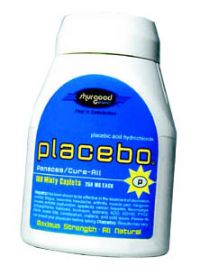The power of placebo revealed
 |
Using fancy brain scanning equipment (PET scans), scientists have been able to shed some light on how placebos work their magic. In this case, via suggestive opioid release:
In the experiment, scientists applied a placebo cream to volunteers’ forearms; volunteers were told it was a pain reliever, though the cream was not. Next, a control cream was applied to a nearby area, and subjects were told it had no effect. Researchers then placed a painfully hot stimulus (similar to a very hot cup of coffee) to both forearm areas and used positron emission tomography (PET) scans to measure and compare brain activity during each application. They found that the placebo treatment caused the brain to release more opioids, a chemical produced by the body and released by the brain, to relieve pain.
The scientists discovered that in the first area treated with a placebo, which volunteers falsely believed to have been treated with a pain reliever, opioid release occurred in brain areas associated with pain relief—in particular, the periadqeductal gray, an area in the brainstem used in neurosurgical interventions to control chronic pain. They also found opioid release in the orbitofrontal cortex and anterior cingulate, parts of the cerebral cortex thought to be related to evaluating and orchestrating responses in the brain and body to deal with a perceived threat—producing, for example, the so-called flight-or-fight response.
Placebo also works great as a stimulant, and appetite suppressant, and an intoxicant! No wonder placebo is abused by teens more than any other drug.
|

Recently @ DoseNation
|
|






















The comments posted here do not reflect the views of the owners of this site.